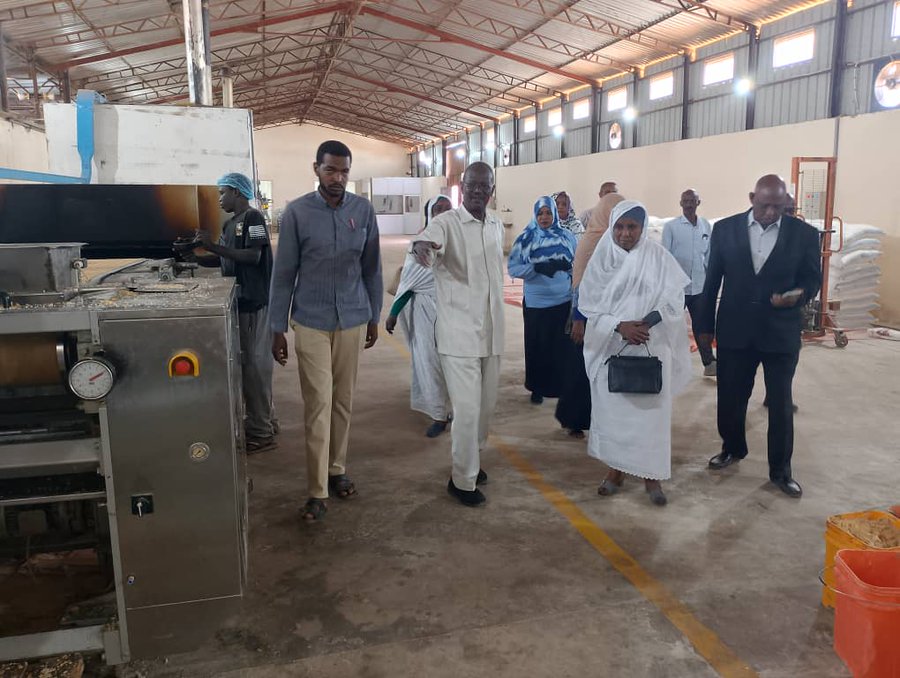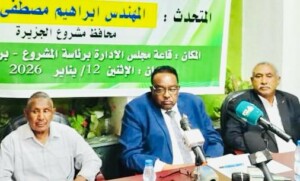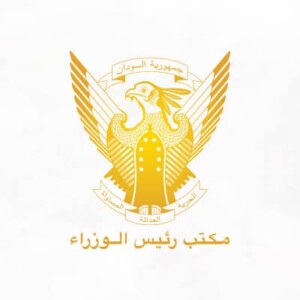Sudan currency rate continues to decline as 90% of industries destroyed

Fatima El Hajj, acting Finance Minister in White Nile state, visits factories near Kosti, February 1 (Photo: SUNA)
The official exchange rate of the US Dollar witnessed an increase of nine per cent in Sudan this week. Economist Haisam Fathi attributes the rise to the consequences of the war between the Sudan Armed Forces (SAF) and Rapid Support Forces (RSF) raging in the country since April 15 last year. White Nile state has reportedly become the largest state in the country that exports food grains and gum arabic.
The greenback was trading for SDG1,050 at the Omdurman National Bank and SDG1,035 at the Bank of Khartoum on Wednesday, SDG85 (nine per cent) more than the day before. The US Dollar rate at the parallel market increased only slightly, to SDG1,120, compared to SDG1,115 last week.
Economist Haisam Fathi attributed the rise in the exchange rate of hard currencies to “the continuation of the war for more than nine months, which led to the complete cessation of industrial production and also the export, the decline of the agricultural sector, as well as the large demand for the dollar by Sudanese travelling abroad and the increase in imports, legally and illegally”.
He told Radio Dabanga in an interview on Wednesday that “the high cost of production, the increasing prices of fuel, electricity, and imported goods needed by the people, and the escalation of the inflation rate due to the decline in the value of the national currency.”
“The devaluation of the pound could have had a positive impact on exports, but the instability of the situation in Sudan did not allow to capitalise on that point,” the economist said.
Regarding the government’s decision to raise the rate of the dollar for customs processing from SDG650 to SDG950, Fathi told Radio Dabanga that “the measure is expected to add to the state revenues, like the increased fees and taxes the current year’s national budget is depending on, because they have lost most of the revenues because of the war”.
He warned that “the 30 per cent tariff increase of the customs dollar will lead to a rise in prices at a similar rate”, similar to the predictions of economist Hasan Bashir, who called the 2024 national budget “a war budget”.
Fathi added that the continued movement of Sudanese to neighbouring countries in search of stability, continued education, and investment has also caused an increase in demand for dollars.
Economic analyst Kamal Karrar in October last year attributed the volatility in Sudan’s foreign exchange market also to the influence of brokers and speculators, who capitalise on price fluctuations of the pound, and attempt to drive up fuel and commodity prices.
Sudan’s General Intelligence Service (GIS) in end September accused the RSF of foreign currency speculation.
Affected
Fathi warned of the dire economic consequences of the war on trade movement at Sudan’s Red Sea ports and the tensions in the Bab El Mandeb strait off the Yemeni coast. “This will also affect landlocked neighbouring countries such as Ethiopia and Chad.”
He also expressed his concerns about the great impact of the war on the agricultural sector, “in particular in the largest agricultural production states, El Gezira, Sennar, and El Gedaref”.
The UN Food and Agriculture Organisation (FAO) reported in December that at least 37 per cent of the people in Sudan is grappling with severe levels of food insecurity.
As for the industrial sector, estimates put the losses at more than US$30 billion and caused layoffs of more than $1 million.
The industrial sector was mainly dependent on three states: Khartoum, El Gezira, and South Darfur. “These three states are under control of the RSF, in addition to a large part of the Darfur region, and parts of Kordofan,” he explained.
“The cessation of the industrial sector prompted traders to import food and other goods from neighbouring countries, legally and illegally, which increased the demand for the dollar.”
The acting Sudanese Minister of Industry, Mahasen Yagoub, said in a press statement in December last year that more than 90 per cent of the factories in Khartoum state were destroyed. “This is especially dire because most of the industry was concentrated in the capital, which led to the loss of many consumer goods.”
The economist explained that especially the export of livestock has been affected by the war, as Darfur and Kordofan, which are the largest farming areas for cattle, sheep, and goats.
However, Hasan El Tom, undersecretary of the Ministry of Animal Resources, reported in early January that livestock exports last year amounted to nearly five million heads (more than four million sheep and 600,000 camels, cows, and goats), an unprecedented number in the past five years, despite the war in the country.
Jibril Ibrahim, leader of a Justice and Equality Movement faction and acting finance minister, said in a radio interview last week that the export of livestock has not stopped despite the war. He noted that the Houthi attacks on vessels in the Red Sea are affecting the traffic at the Sudanese ports.
As for the industries, they could be moved to safe areas whereby the metals sector in particular is to be activated. The finance minister also claimed that “agriculture in the safe parts of Sudan can prevent famine” in the country.
Losses
According to unofficial estimates, government losses now amount to $30 billion, while the losses of the war to the population are estimated at $100 billion, Fathi said.
He expressed optimism about the possibility of reconstruction after the cessation of the war, expecting support from major countries and organisations, “similar to previous experiences in post-war reconstruction”. At the same time, he stressed the need for government action to restore the infrastructure and compensate for the loss of personal property.
In end December, Shaza Balla, country director of the Centre for International Private Enterprise (CIPE) in Sudan, told Radio Dabanga that the extensive destruction the war caused to the commercial, industrial, agricultural, and service sectors, so far amounted to $15 billion, “equivalent to 48 per cent of Sudan’s GDP”.
The economic situation before the start of the war in mid-April last year already showed “dismal performance”. Reports in 2022 indicated that the value of the Sudanese Pound decreased 20 times (2,000 per cent) in the previous five years.
White Nile state
Factories are still functioning White Nile state in southern Sudan, which is still under control of the Sudanese army.
Yesterday, Fatima El Hajj, acting Finance Minister in the state, visited the Norris International Company for exports of oilseeds and gum arabic, the El Mashreqa Food Industries Group and a new biscuit factory near Kosti.
She said that White Nile state is encouraging “investment opportunities and investors in exports and the localisation of industries,” Sunda News agency reported yesterday.
Abdallah Ismail, the state’s investment commissioner, explained that his government is keen to achieve its overall goals of increasing job opportunities, export revenues, food security, and achieving sustainable development.
He said that the state has become the largest state for exporting food grains and gum arabic after other exporting states stopped due to the war. “White Nile state is working to encourage investment and provide all facilities to investors in accordance with the federal and state investment law.”











 and then
and then